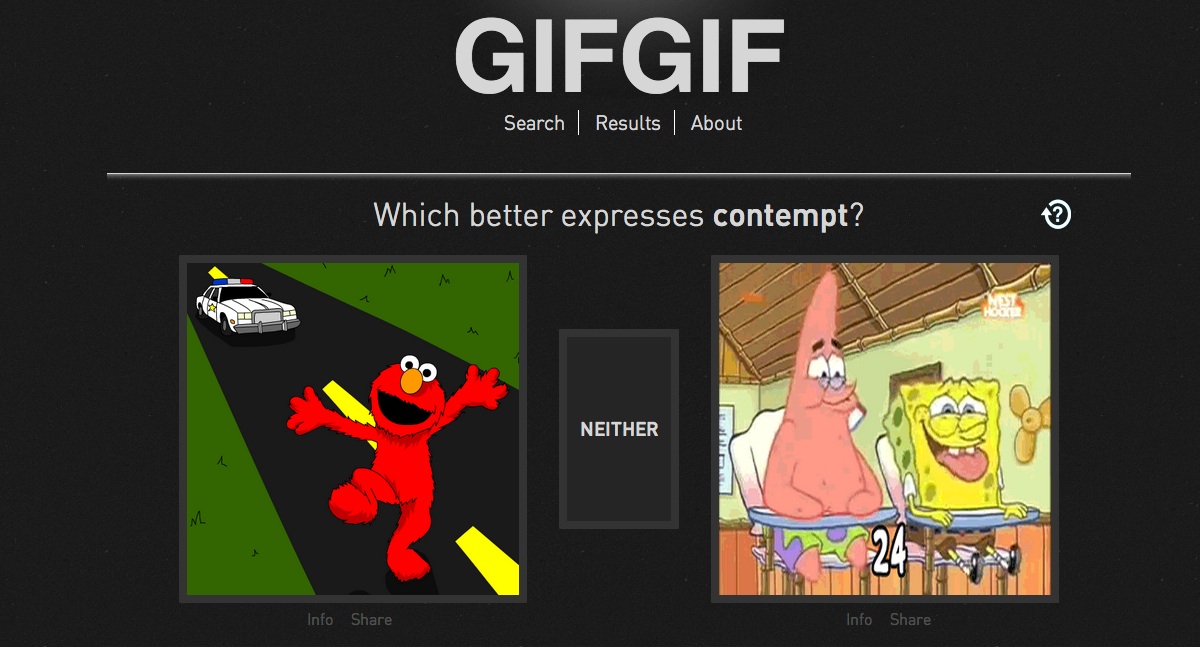MIT Students Are Trying to Create a Language Based on GIFs

Photo via GIFGIF
GIFs could one day be the new emojis.
Well, that’s sort of the plan, according to two MIT Media Lab students who have embarked on a journey to quantify people’s emotions based on how they perceive the animated photographs.
“GIFGIF,” started by Travis Rich and Kevin Hu, began as a side project with the intention of identifying patterns of human perception when people are presented with both a word, and accompanying GIFs. But after playing around with GIFGIF for awhile, the creators decided it could do a lot more than that.
“An animated GIF is a magical thing. It contains the power to convey emotion, empathy, and context in a subtle way that text or emoticons simply can’t,” Rich and Hu said of their project. “GIFGIF is a project to capture that magic with quantitative methods. Our goal is to create a tool that lets people explore the world of GIFs by the emotions they evoke.”
When signing onto GIFGIF, users are presented with two options on the screen, and are asked to decide how the image best describes the word that’s displayed next to them. For example, GIFGIF will ask “Which better expresses sadness?,” and will then show an image of, say, Steve Buscemi making a sullen facial expression alongside an image of a woman loading a gun. The user can either pick between the images, or click “neither” to move onto the next set, which pairs together from more than 4,400 images in their current database.
According to Quartz, Hu and Rich were sitting nearby another group of students in the lab, called the Place Pulse, who were using a multiple-choice system to gauge people’s reactions to how a particular city makes them feel when looking at two photos. Hu and Rich, after talking about the power of GIFs and how they can elicit certain emotions, decided that the same process Place Pulse was using for their project could be used to measure similar reactions for GIFs.
So why create a system like this? Hu and Rich explain:
Because GIFs are awesome. Also, we’re hoping to answer some really interesting questions. Does a GIF’s emotional variance impact how it’s received? We have a hunch that emotional variance is why “:)” is pretty acceptable but “;)” is typically an awkward mix of creepy/sexy/playful/pirate-y. Does a GIF’s emotional content vary between cultures? For example, what is the best representation of happiness for Germans, compared to a Canadian’s impression? And certainly, let’s not forget, we just want to build a better way to find GIFs that capture that exact emotion you’re looking for.
While it’s still clearly in its infancy, GIFGIF creators hope to build out an API that can be used by researchers as well as a text-to-GIF generator. “Our goal is to make a GIF website–not solve the open questions of universal human emotions,” they said in an email to Boston. “Finding the right GIF is an enormous barrier, especially for those from different cultures or generations. Using a GIF can sometimes be like speaking a second language. We want to contribute to the lowering of those barriers, acting as a dictionary between words and GIFs. If people can communicate their emotions and ideas almost universally, breaking the barriers of language—that would be powerful, and that’s our vision.”
Imagine: One day people won’t have to over-analyze a text-message emoticon sent to their smartphone. Instead, they will be able to distinguish what a person’s intended emotion is, all thanks to information generated and sorted by GIFGIF.
That’s cause for celebration:


